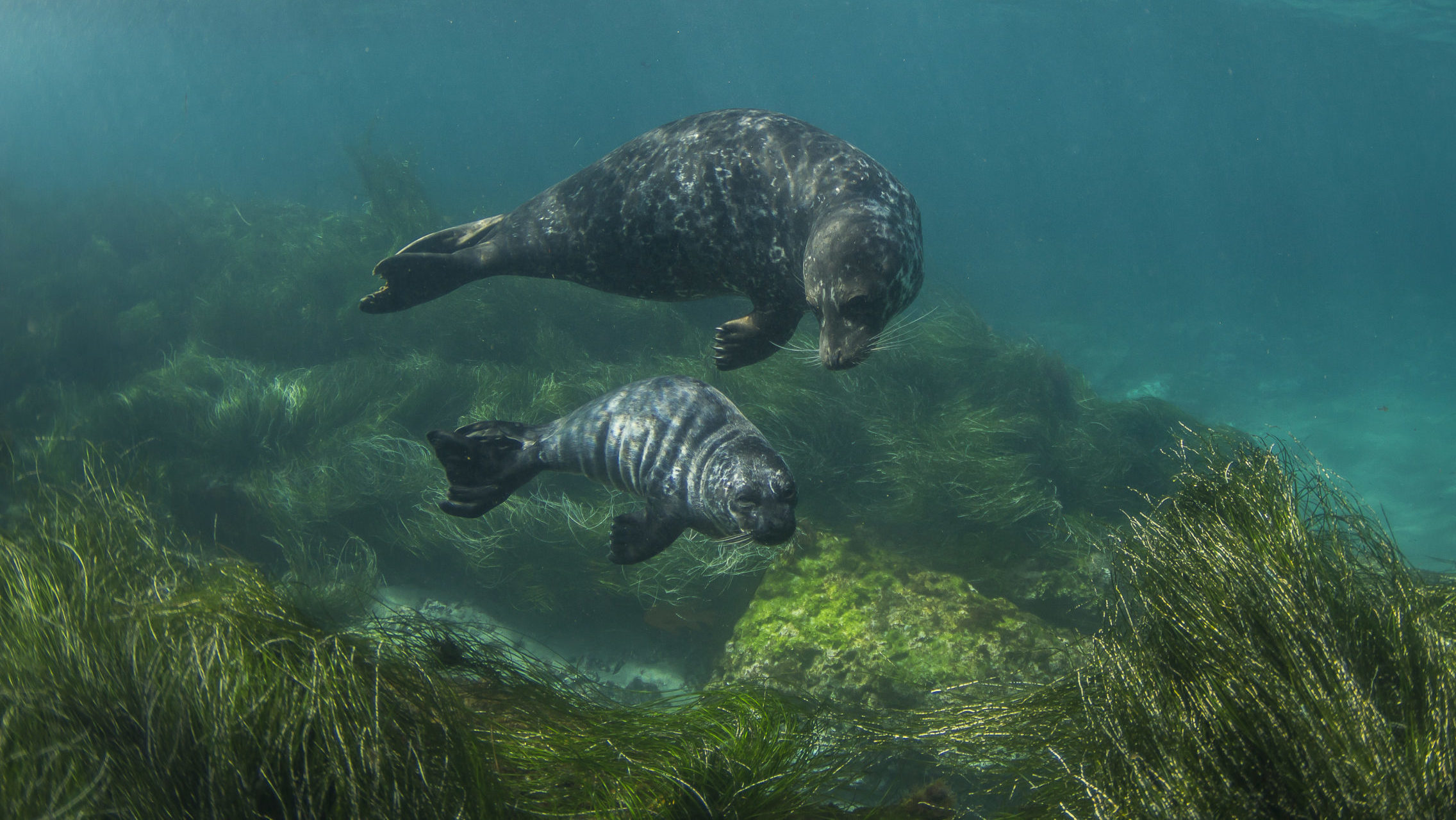
Mother seal with her pup. Photo: Jeff Hester / Ocean Image Bank
Summary
- Marine protection investments are expected to increase as the world works toward meeting targets to protect 30 percent of land and ocean area by 2030.
- Ensuring good water quality and holistic ecosystem management will be critical to achieve the biodiversity and ecological goals of marine protection.
- Poor water quality is a top threat to marine and coastal ecosystem health and resilience, and wastewater pollution is driving coastal water quality declines and affecting marine ecosystem health in many places, including within marine protected areas (MPAs).
- Wastewater generates widespread, significant, and well-documented impacts on coastal and marine ecosystems. It remains a serious yet overlooked threat globally.
- The urgency of addressing wastewater pollution is only increasing with climate change, as accumulating evidence shows that the two threats compound one another.
- Wastewater and sewage pollution are avoidable. Addressing the causes of poor water quality can support the success of necessary efforts like 30×30 to conserve and protect our ocean and its unique habitats.
Marine protection investments are expected to grow as the world works toward meeting 30×30 targets, increasing the importance of thinking holistically about marine ecosystem protection.
“30×30” is the global effort to protect at least 30 percent of the world’s land and sea area by 2030. This target was set as part of the first draft of the Convention on Biological Diversity’s Post-2020 Biodiversity Framework, which will set targets that all parties agree to work toward. While the framework is still being negotiated, the ambitious 30×30 goal is already being championed. For example, President Biden has pledged to put the U.S. on the path to achieving 30×30.1 Meeting this goal will require unprecedented investments in marine conservation.
To succeed, conservation efforts must be implemented with consideration of other factors influencing the biodiversity they seek to protect.
In coastal and marine ecosystems, water quality significantly influences ecosystem health, and MPA effectiveness largely depends on water quality.2,3 As a global assessment of the need for broader marine spatial planning (including consideration of local pollution) around MPAs noted,
Marine protected areas and other local management measures are important, but they cannot alone act to protect ecosystems from the damaging effects of human activity within and outside of areas. Not considering the context in which oases of protection sit essentially means putting the conservation or management investment at risk: not only are marine biodiversity and ecosystem services compromised but also the time and resources spent protecting an area that no longer remains protected are wasted.4
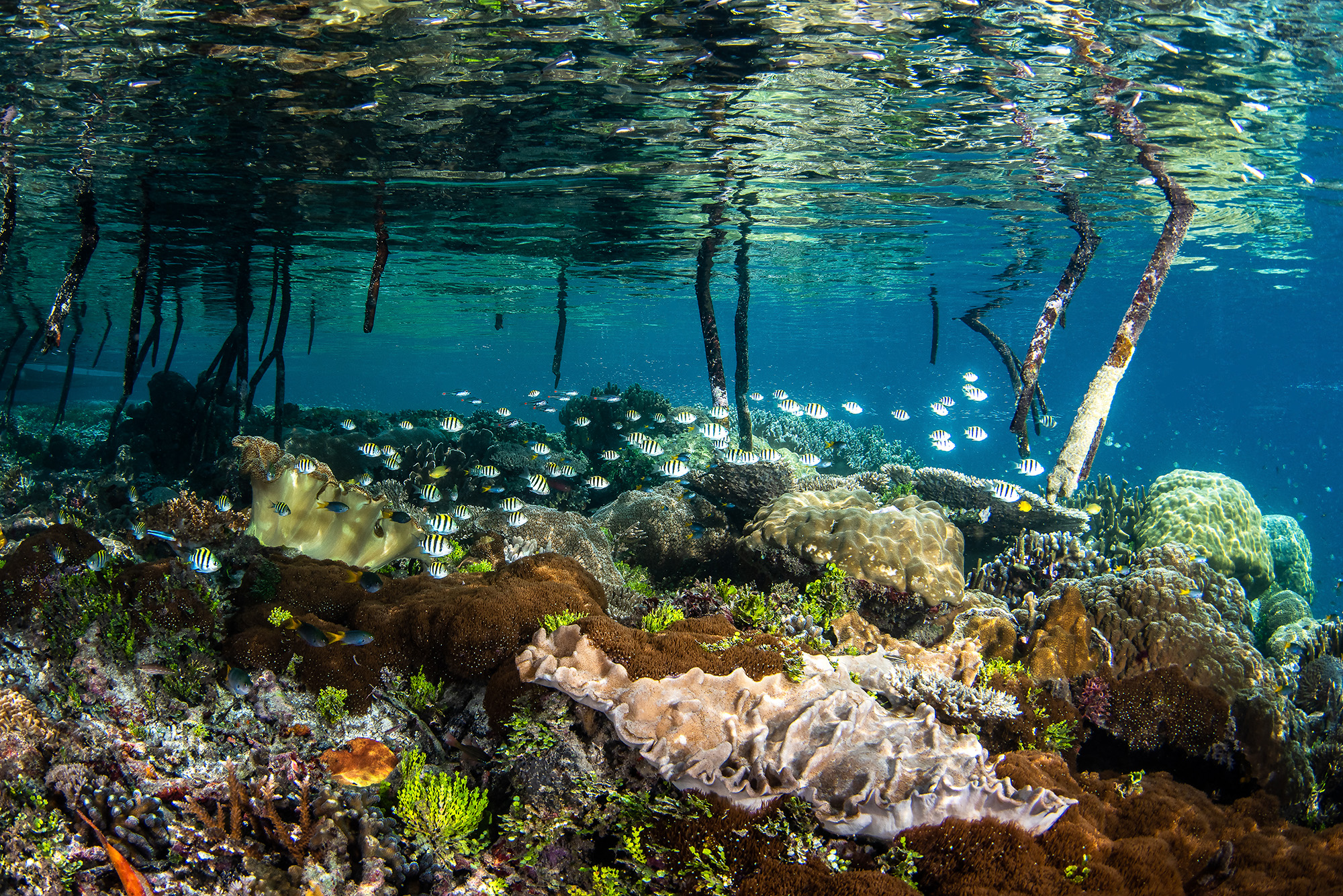
Coral reef below mangrove roots in Indonesia. Photo: Brook Peterson / Ocean Image Bank
Poor water quality is a top threat to marine ecosystem health and resilience.5,6
A review on the topic noted that “progressive increases in nutrient concentration and altered nutrient ratio have been reported from the Baltic Sea, Waden Sea, North Sea, Black Sea, Adriatic Sea, Dutch Sea, Japan Sea, the Gulf of Thailand, the Indian Ocean and the bays and coasts of many countries.”7 Excess nutrients in the marine environment can lead to eutrophication, which threatens ecosystems by reducing dissolved oxygen levels.8 Eutrophic coastal ecosystems have increased globally from less than five prior to World War II to around 700 as of 2020 (even this figure is probably an underestimate).9 When oxygen levels drop too low, areas with little or no oxygen (also known as dead zones) form and lead to marine life mortality.10 Nutrient pollution can also lead to algal blooms that can block sunlight, suffocate and poison marine life, and increase ocean acidification.11,12,13 Coastal algal blooms and dead zones are expected to increase in frequency, distribution, and intensity around the world.14,15 Coral reefs may experience particularly significant impacts from nutrient pollution, eutrophication, and algal blooms, such as changes in community structure, bleaching, and decreased resilience.16,17,18 While agricultural sources of nutrient pollution often receive a significant amount of attention for these impacts, in many places wastewater contributes the most nutrient pollution to coastal waters.19,20,21
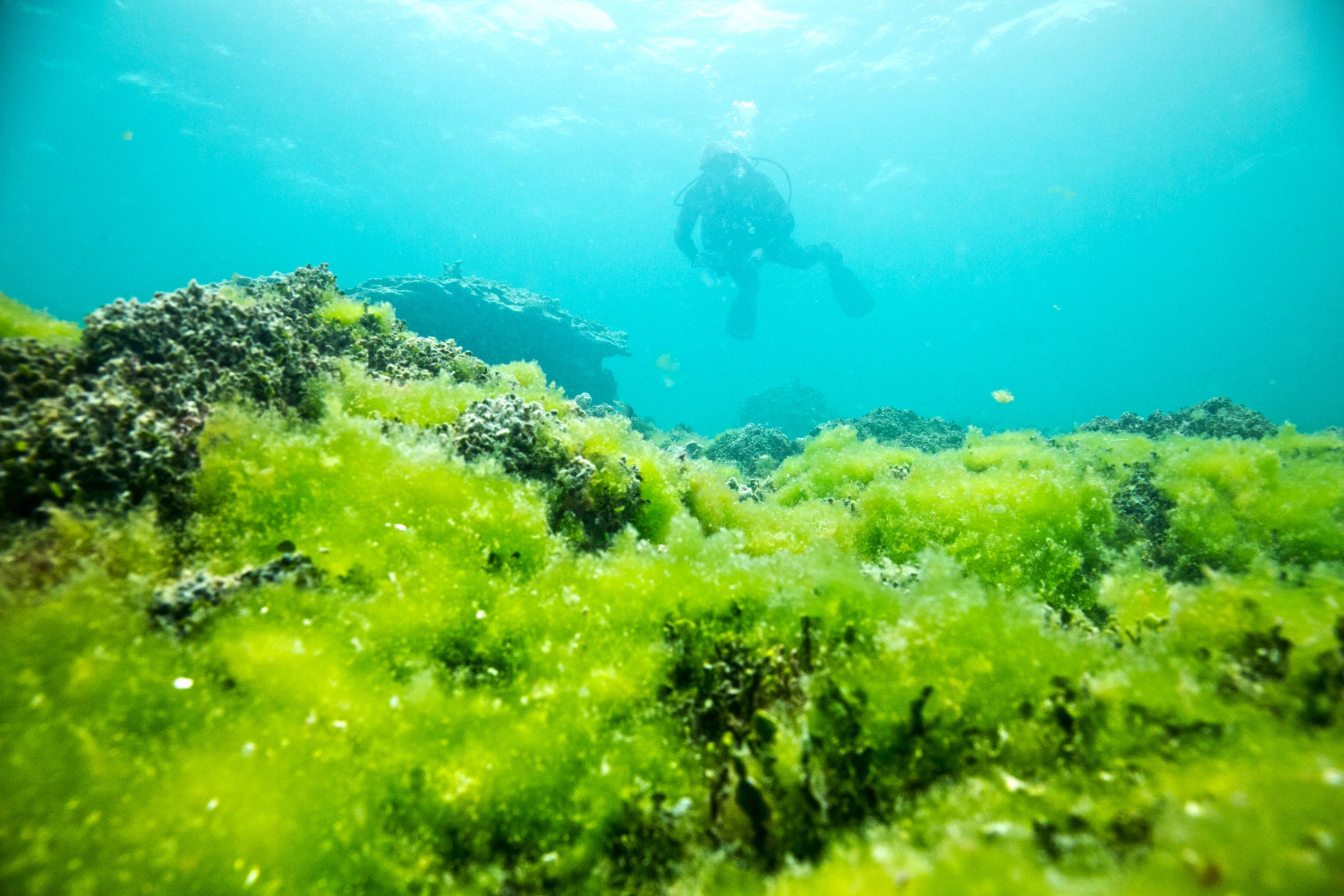
Algae growing on bleached corals near Lisianski Island in Papahānaumokuākea Marine National Monument. Photo: Public domain, via Wikimedia Commons
MPA designations do not protect habitats from the impacts of poor water quality and eutrophication, and research suggests that the extent of pollution affecting MPAs globally has been underestimated.22,23
In some cases, sewage outfalls are even adjacent to MPAs.24,25 One study found that three sewage outfalls near Cape D’Aguilar Marine Reserve in Hong Kong were a major and continuous source of endocrine-disrupting compounds into the reserve.26 Even when outfalls are farther from MPAs, wastewater can travel great distances off the coast. For example, research demonstrated that runoff from two floods in Houston, Texas, carried sewage to coral reefs more than 100 miles offshore at the Flower Garden Banks National Marine Sanctuary.27 Notable case studies have confirmed the impact of wastewater pollution on MPAs. A decade ago, research demonstrated that a disease leading to the decline and eventual listing of Caribbean elkhorn coral under the U.S. Endangered Species Act was caused by a human pathogen found in wastewater.28 Increased outbreaks of Crown of Thorns starfish, which have greatly reduced coral cover on the Great Barrier Reef in Australia, have been linked to nutrient pollution.29,30
Wastewater generates widespread, significant, and well-documented impacts on coastal and marine ecosystems.
Wastewater is either residential, commercial, or industrial used water and can contain sewage, nutrients, pharmaceuticals, heavy metals, pathogens, microplastics, and suspended solids that increase turbidity. Each of these components has been shown to affect marine ecosystem health. In addition to the impacts of its components, wastewater can alter the temperature, pH, and salinity of coastal waters.31 Seagrasses are one of the most threatened ecosystems on Earth and have been severely declining for decades.32,33 They are early indicators of water quality and clarity in coastal environments.34 Their decline has been attributed to the water quality impacts of sediments, which affect light availability and cause smothering, and excess nutrients. Wastewater is a key driver of both sediment and nutrient pollutants in marine ecosystems. Likewise, research indicates that, globally, more than 30 percent of salt marshes, which are crucial for healthy fisheries and coastal resilience, are highly contaminated with sewage.35 One study documented sewage pollution problems in 104 of the 112 areas globally that are home to both coral reefs and humans.36 Wastewater has been shown to stunt growth, increase disease, and lower reproductive rates in coral species.37 Excess nutrient pollution leading to algal overgrowth also affects coral health.38 Despite this, pollution can be overlooked by reef managers.39
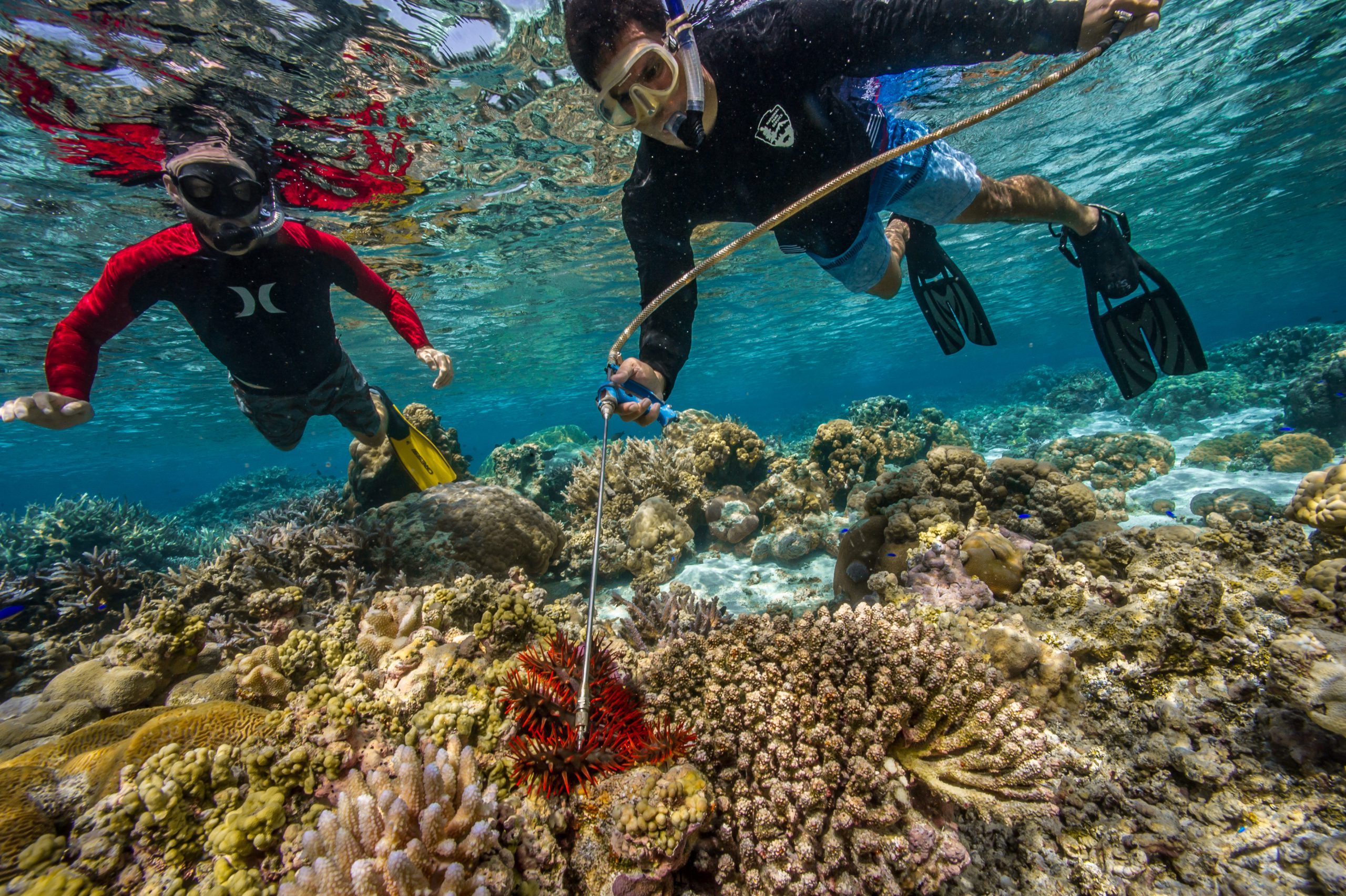
Divers inject the central disk of a Crown of Thorns Starfish to control population, American Samoa. Photo: Shaun Wolfe / Ocean Image Bank
Wastewater is a serious yet overlooked threat to coastal and marine ecosystems globally.
Wastewater pollution is a global threat affecting nearly every populated coastline on Earth. In fact, human sewage is considered the primary source of nutrient pollution in urban areas.40 Globally, 80 percent of sewage is discharged into the environment untreated, and for decades coastal sewage discharges have been increasing significantly.41,42 Despite the severity of the threat, coastal sewage pollution is relatively overlooked and underfunded by philanthropy, especially in comparison to other ocean threats. A funding analysis commissioned in 2019 found that ocean sewage pollution received only USD 6 million annually in philanthropic funding between 2006 and 2019.43 Total philanthropic funding for marine conservation in the year 2016 alone was USD 621 million.44
The urgency of addressing wastewater pollution is only increasing with climate change, as accumulating evidence shows that the two threats interact to increase ocean acidification, intensify harmful algal blooms, and degrade ecosystems critical to coastal resilience.
The deleterious impacts of both climate change and wastewater pollution can compound one another, driving even more degradation in important marine habitats.45 Eutrophication caused by nutrient pollution can also exacerbate ocean acidification by pumping more CO2 into the water.46 Increased nutrient pollution interacts with warmer temperatures to drive more coastal algal blooms.47 Meanwhile, increasing coastal storms and flooding as a result of climate change threaten already vulnerable and failing wastewater infrastructure. Climate change will exacerbate combined sewer overflows, which will drive even more pollution into the ocean more frequently.48 Nutrient and sewage pollution have been shown to weaken and decrease resilience in saltmarshes, mangroves, and oyster reefs.49,50,51 These coastal habitats are critical to the health of valuable commercial fisheries and increasingly important for coastal resilience for both nature and people.52,53,54 These findings have significant implications for commercial fisheries and the climate resilience of both human communities and coastal and marine ecosystems.
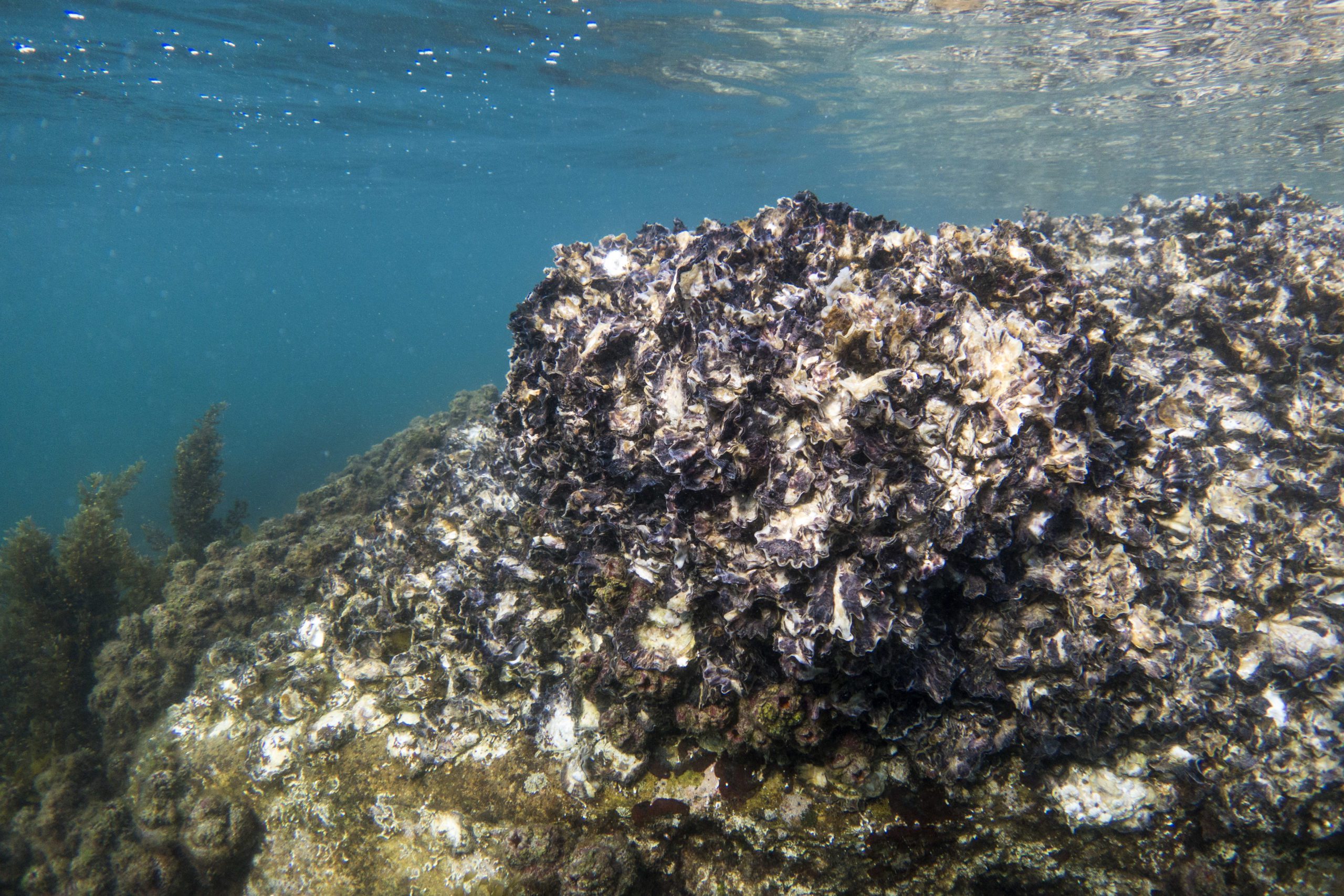
Oysters at Shiprock, Australia. Photo: John Turnbull
Water quality is best protected through prevention, and wastewater and sewage pollution are avoidable.
Solutions to combat wastewater pollution are already available. In fact, many such solutions are low-hanging fruit, especially relative to the complex threats of climate change and overfishing. For example, options for decreasing wastewater pollution include treatment facility upgrades, wastewater reuse, constructed wetlands, and on-site wastewater treatment systems. In rural and low-income areas, simple and affordable solutions are making waste treatment more accessible.55,56 Other interventions for reducing nutrient pollution include supporting nutrient credit trading programs (like the one implemented in the Chesapeake Bay) and championing sustainable macroalgal and bivalve aquaculture.57 In fact, the issue is so underprioritized that there is room for investments to produce real impacts. Coral reef managers, for example, spend less time and money on sewage than on fisheries management and MPAs, despite considering sewage a top threat to reef health.58 Implementing solutions to improve coastal water quality will not only bolster declining marine ecosystems like coral reefs and seagrasses, but will ensure livelihoods and food security for vulnerable coastal communities.
Addressing the causes of poor water quality will ensure the success of necessary efforts like 30×30 to conserve and protect our ocean and its unique habitats.
There is hope: in places where wastewater pollution has been addressed, coastal water quality and marine ecosystem health have improved. For example, in 2001 the state of Massachusetts invested USD 3.8 billion to build a wastewater treatment plant to pipe effluent nearly 10 miles out from shore. Since its completion, nitrogen levels in Boston Harbor have declined 80 percent and, from 2006 to 2016, harbor seagrasses increased 50 percent.59 The same trend has been observed elsewhere in the U.S. and also across Europe, with water quality improvement actions leading to rebounding populations of seagrasses in Denmark, Portugal, and Spain.60 In Bermuda, research has shown that implementing policies to manage sewage impacts has indeed resulted in declines in sewage prevalence on coral reefs.61 These examples demonstrate that action, where taken, leads to improved outcomes for marine ecosystems. The political will and funding to increase marine protection are growing because of the 30×30 target. Addressing wastewater as a cause of poor water quality will strengthen those investments and help ensure resilient and healthy marine ecosystems and fisheries into the future.
Notes
- The White House. “Executive Order on Tackling the Climate Crisis at Home and Abroad,” January 27, 2021. https://www.whitehouse.gov/briefing-room/presidential-actions/2021/01/27/executive-order-on-tackling-the-climate-crisis-at-home-and-abroad/.
- Rodríguez-Rodríguez, David. “Chapter 25 – Marine Protected Areas: Attempting the Sustainability of the Seas.” In World Seas: An Environmental Evaluation, edited by Charles Sheppard, Second Edition., 475–89. Academic Press, 2019. https://doi.org/10.1016/B978-0-12-805052-1.00028-0.
- MPA News Staff. “Managing Water Quality in MPAs: How Practitioners Are Handling the Challenges | MPA News.” MPA News, February 15, 2002. https://mpanews.openchannels.org/news/mpa-news/managing-water-quality-mpas-how-practitioners-are-handling-challenges.
- Agardy, Tundi, Giuseppe Notarbartolo di Sciara, and Patrick Christie. “Mind the Gap: Addressing the Shortcomings of Marine Protected Areas through Large Scale Marine Spatial Planning.” Marine Policy 35, no. 2 (March 1, 2011): 226–32. https://doi.org/10.1016/j.marpol.2010.10.006.
- Halpern, Benjamin S., Kimberly A. Selkoe, Fiorenza Micheli, and Carrie V. Kappel. “Evaluating and Ranking the Vulnerability of Global Marine Ecosystems to Anthropogenic Threats.” Conservation Biology 21, no. 5 (2007): 1301–15. https://doi.org/10.1111/j.1523-1739.2007.00752.x.
- Halpern, Benjamin S., Melanie Frazier, Jamie Afflerbach, Julia S. Lowndes, Fiorenza Micheli, Casey O’Hara, Courtney Scarborough, and Kimberly A. Selkoe. “Recent Pace of Change in Human Impact on the World’s Ocean.” Scientific Reports 9, no. 1 (December 2019): 11609. https://doi.org/10.1038/s41598-019-47201-9.
- Shahidul Islam, Md., and Masaru Tanaka. “Impacts of Pollution on Coastal and Marine Ecosystems Including Coastal and Marine Fisheries and Approach for Management: A Review and Synthesis.” Marine Pollution Bulletin 48, no. 7 (April 1, 2004): 624–49. https://doi.org/10.1016/j.marpolbul.2003.12.004.
- Malone, Thomas C., and Alice Newton. “The Globalization of Cultural Eutrophication in the Coastal Ocean: Causes and Consequences.” Frontiers in Marine Science, 2020. https://doi.org/10.3389/fmars.2020.00670.
- Malone, Thomas C., and Alice Newton. “The Globalization of Cultural Eutrophication in the Coastal Ocean: Causes and Consequences.” Frontiers in Marine Science, 2020. https://doi.org/10.3389/fmars.2020.00670.
- Altieri, Andrew H., Seamus B. Harrison, Janina Seemann, Rachel Collin, Robert J. Diaz, and Nancy Knowlton. “Tropical Dead Zones and Mass Mortalities on Coral Reefs.” Proceedings of the National Academy of Sciences 114, no. 14 (April 4, 2017): 3660–65. https://doi.org/10.1073/pnas.1621517114.
- Wallace, Ryan B., Hannes Baumann, Jason S. Grear, Robert C. Aller, and Christopher J. Gobler. “Coastal Ocean Acidification: The Other Eutrophication Problem.” Estuarine, Coastal and Shelf Science 148 (July 5, 2014): 1–13. https://doi.org/10.1016/j.ecss.2014.05.027.
- US EPA. “The Effects: Dead Zones and Harmful Algal Blooms.” Overviews and Factsheets. US EPA, March 12, 2013. https://www.epa.gov/nutrientpollution/effects-dead-zones-and-harmful-algal-blooms.
- Reef Resilience Network. “Impacts on Marine Life.” Reef Resilience Network. https://reefresilience.org/wastewater-pollution/impacts-on-marine-life/.
- Nelson, Hannah R., and Andrew H. Altieri. “Oxygen: The Universal Currency on Coral Reefs.” Coral Reefs 38, no. 2 (April 2019): 177–98. https://doi.org/10.1007/s00338-019-01765-0.
- Bauman, Andrew G., John A. Burt, David A. Feary, Elise Marquis, and Paolo Usseglio. “Tropical Harmful Algal Blooms: An Emerging Threat to Coral Reef Communities?” Marine Pollution Bulletin 60, no. 11 (November 2010): 2117–22. https://doi.org/10.1016/j.marpolbul.2010.08.015.
- Wear, Stephanie, and Rebecca Vega Thurber. “Sewage Pollution: Mitigation Is Key for Coral Reef Stewardship: Sewage Pollution and Coral Reef Stewardship.” Annals of the New York Academy of Sciences 1355 (May 8, 2015). https://doi.org/10.1111/nyas.12785.
- Bauman, Andrew G., John A. Burt, David A. Feary, Elise Marquis, and Paolo Usseglio. “Tropical Harmful Algal Blooms: An Emerging Threat to Coral Reef Communities?” Marine Pollution Bulletin 60, no. 11 (November 2010): 2117–22. https://doi.org/10.1016/j.marpolbul.2010.08.015.
- Altieri, Andrew H., Seamus B. Harrison, Janina Seemann, Rachel Collin, Robert J. Diaz, and Nancy Knowlton. “Tropical Dead Zones and Mass Mortalities on Coral Reefs.” Proceedings of the National Academy of Sciences 114, no. 14 (April 4, 2017): 3660–65. https://doi.org/10.1073/pnas.1621517114.
- Kinney, Erin L., and Ivan Valiela. “Nitrogen Loading to Great South Bay: Land Use, Sources, Retention, and Transport from Land to Bay.” Journal of Coastal Research 27, no. 4 (July 1, 2011): 672–86. https://doi.org/10.2112/JCOASTRES-D-09-00098.1.
- Lapointe, Brian E., Peter J. Barile, Mark M. Littler, and Diane S. Littler. “Macroalgal Blooms on Southeast Florida Coral Reefs: II. Cross-Shelf Discrimination of Nitrogen Sources Indicates Widespread Assimilation of Sewage Nitrogen.” Harmful Algae 4, no. 6 (November 1, 2005): 1106–22. https://doi.org/10.1016/j.hal.2005.06.002.
- Carruthers, T. J. B., B. I. van Tussenbroek, and W. C. Dennison. “Influence of Submarine Springs and Wastewater on Nutrient Dynamics of Caribbean Seagrass Meadows.” Estuarine, Coastal and Shelf Science 64, no. 2 (August 1, 2005): 191–99. https://doi.org/10.1016/j.ecss.2005.01.015.
- Agardy, Tundi, Giuseppe Notarbartolo di Sciara, and Patrick Christie. “Mind the Gap: Addressing the Shortcomings of Marine Protected Areas through Large Scale Marine Spatial Planning.” Marine Policy 35, no. 2 (March 1, 2011): 226–32. https://doi.org/10.1016/j.marpol.2010.10.006.
- Abessa, Denis M. S., Heitor C. Albuquerque, Lucas G. Morais, Giuliana S. Araújo, Tainá G. Fonseca, Ana C. F. Cruz, Bruno G. Campos, et al. “Pollution Status of Marine Protected Areas Worldwide and the Consequent Toxic Effects Are Unknown.” Environmental Pollution 243 (December 1, 2018): 1450–59. https://doi.org/10.1016/j.envpol.2018.09.129.
- Abessa, Denis M. S., Heitor C. Albuquerque, Lucas G. Morais, Giuliana S. Araújo, Tainá G. Fonseca, Ana C. F. Cruz, Bruno G. Campos, et al. “Pollution Status of Marine Protected Areas Worldwide and the Consequent Toxic Effects Are Unknown.” Environmental Pollution 243 (December 1, 2018): 1450–59. https://doi.org/10.1016/j.envpol.2018.09.129.
- Xu, Elvis G. B., Shan Liu, Guang-Guo Ying, Gene J. S. Zheng, Joseph H. W. Lee, and Kenneth M. Y. Leung. “The Occurrence and Ecological Risks of Endocrine Disrupting Chemicals in Sewage Effluents from Three Different Sewage Treatment Plants, and in Natural Seawater from a Marine Reserve of Hong Kong.” Marine Pollution Bulletin, 7th International Conference on Marine Pollution and Ecotoxicology, 85, no. 2 (August 30, 2014): 352–62. https://doi.org/10.1016/j.marpolbul.2014.02.029.
- Xu, Elvis G. B., Shan Liu, Guang-Guo Ying, Gene J. S. Zheng, Joseph H. W. Lee, and Kenneth M. Y. Leung. “The Occurrence and Ecological Risks of Endocrine Disrupting Chemicals in Sewage Effluents from Three Different Sewage Treatment Plants, and in Natural Seawater from a Marine Reserve of Hong Kong.” Marine Pollution Bulletin, 7th International Conference on Marine Pollution and Ecotoxicology, 85, no. 2 (August 30, 2014): 352–62. https://doi.org/10.1016/j.marpolbul.2014.02.029.
- Shore, Amanda, Jordan A. Sims, Michael Grimes, Lauren I. Howe-Kerr, Carsten G. B. Grupstra, Shawn M. Doyle, Lauren Stadler, et al. “On a Reef Far, Far Away: Anthropogenic Impacts Following Extreme Storms Affect Sponge Health and Bacterial Communities.” Frontiers in Marine Science 0 (2021). https://doi.org/10.3389/fmars.2021.608036.
- Sutherland, Kathryn Patterson, Sameera Shaban, Jessica L. Joyner, James W. Porter, and Erin K. Lipp. “Human Pathogen Shown to Cause Disease in the Threatened Eklhorn Coral Acropora Palmata.” PLOS ONE 6, no. 8 (August 17, 2011): e23468. https://doi.org/10.1371/journal.pone.0023468.
- Brodie, Jon, Katharina Fabricius, Glenn De’ath, and Ken Okaji. “Are Increased Nutrient Inputs Responsible for More Outbreaks of Crown-of-Thorns Starfish? An Appraisal of the Evidence.” Marine Pollution Bulletin, Catchment to Reef: Water Quality Issues in the Great Barrier Reef Region, 51, no. 1 (January 1, 2005): 266–78. https://doi.org/10.1016/j.marpolbul.2004.10.035.
- Babcock, Russell C., Jeffrey M. Dambacher, Elisabetta B. Morello, Éva E. Plagányi, Keith R. Hayes, Hugh P. A. Sweatman, and Morgan S. Pratchett. “Assessing Different Causes of Crown-of-Thorns Starfish Outbreaks and Appropriate Responses for Management on the Great Barrier Reef.” PLOS ONE 11, no. 12 (December 30, 2016): e0169048. https://doi.org/10.1371/journal.pone.0169048.
- Reef Resilience Network. “Impacts on Marine Life.” Reef Resilience Network. https://reefresilience.org/wastewater-pollution/impacts-on-marine-life/.
- Santos, Carmen B. de los, Dorte Krause-Jensen, Teresa Alcoverro, Núria Marbà, Carlos M. Duarte, Marieke M. van Katwijk, Marta Pérez, et al. “Recent Trend Reversal for Declining European Seagrass Meadows.” Nature Communications 10, no. 1 (July 26, 2019): 3356. https://doi.org/10.1038/s41467-019-11340-4.
- Orth, Robert J., Tim J. B. Carruthers, William C. Dennison, Carlos M. Duarte, James W. Fourqurean, Kenneth L. Heck, A. Randall Hughes, et al. “A Global Crisis for Seagrass Ecosystems.” BioScience 56, no. 12 (December 1, 2006): 987–96. https://doi.org/10.1641/0006-3568(2006)56[987:AGCFSE]2.0.CO;2.
- Orth, Robert J., Tim J. B. Carruthers, William C. Dennison, Carlos M. Duarte, James W. Fourqurean, Kenneth L. Heck, A. Randall Hughes, et al. “A Global Crisis for Seagrass Ecosystems.” BioScience 56, no. 12 (December 1, 2006): 987–96. https://doi.org/10.1641/0006-3568(2006)56[987:AGCFSE]2.0.CO;2.
- Wear, Stephanie L., Vicenç Acuña, Rob McDonald, and Carme Font. “Sewage Pollution, Declining Ecosystem Health, and Cross-Sector Collaboration.” Biological Conservation 255 (March 1, 2021): 109010. https://doi.org/10.1016/j.biocon.2021.109010.
- Wear, Stephanie, and Rebecca Vega Thurber. “Sewage Pollution: Mitigation Is Key for Coral Reef Stewardship: Sewage Pollution and Coral Reef Stewardship.” Annals of the New York Academy of Sciences 1355 (May 8, 2015). https://doi.org/10.1111/nyas.12785.
- Wear, Stephanie, and Rebecca Vega Thurber. “Sewage Pollution: Mitigation Is Key for Coral Reef Stewardship: Sewage Pollution and Coral Reef Stewardship.” Annals of the New York Academy of Sciences 1355 (May 8, 2015). https://doi.org/10.1111/nyas.12785.
- Altieri, Andrew H., Seamus B. Harrison, Janina Seemann, Rachel Collin, Robert J. Diaz, and Nancy Knowlton. “Tropical Dead Zones and Mass Mortalities on Coral Reefs.” Proceedings of the National Academy of Sciences 114, no. 14 (April 4, 2017): 3660–65. https://doi.org/10.1073/pnas.1621517114.
- Wear, Stephanie L. “Missing the Boat: Critical Threats to Coral Reefs Are Neglected at Global Scale.” Marine Policy 74 (December 1, 2016): 153–57. https://doi.org/10.1016/j.marpol.2016.09.009.
- Malone, Thomas C., and Alice Newton. “The Globalization of Cultural Eutrophication in the Coastal Ocean: Causes and Consequences.” Frontiers in Marine Science, 2020. https://doi.org/10.3389/fmars.2020.00670.
- United Nations World Water Assessment Programme. “The United Nations World Water Development Report 2017. Wastewater: The Untapped Resource.” United Nations World Water Development Report. Paris: United Nations Educational, Scientific and Cultural Organization, March 22, 2017. http://www.unesco.org/new/en/natural-sciences/environment/water/wwap/wwdr/.
- Shahidul Islam, Md., and Masaru Tanaka. “Impacts of Pollution on Coastal and Marine Ecosystems Including Coastal and Marine Fisheries and Approach for Management: A Review and Synthesis.” Marine Pollution Bulletin 48, no. 7 (April 1, 2004): 624–49. https://doi.org/10.1016/j.marpolbul.2003.12.004.
- Independent analysis commissioned by CEA Consulting, 2019.
- Independent analysis commissioned by CEA Consulting, 2019.
- Malone, Thomas C., and Alice Newton. “The Globalization of Cultural Eutrophication in the Coastal Ocean: Causes and Consequences.” Frontiers in Marine Science, 2020. https://doi.org/10.3389/fmars.2020.00670.
- Malone, Thomas C., and Alice Newton. “The Globalization of Cultural Eutrophication in the Coastal Ocean: Causes and Consequences.” Frontiers in Marine Science, 2020. https://doi.org/10.3389/fmars.2020.00670.
- Xiao, Xi, Susana Agustí, Yaoru Pan, Yan Yu, Ke Li, Jiaping Wu, and Carlos M. Duarte. “Warming Amplifies the Frequency of Harmful Algal Blooms with Eutrophication in Chinese Coastal Waters.” Environmental Science & Technology 53, no. 22 (November 19, 2019): 13031–41. https://doi.org/10.1021/acs.est.9b03726.
- Sterk, Ankie, Heleen de Man, Jack F. Schijven, Ton de Nijs, and Ana Maria de Roda Husman. “Climate Change Impact on Infection Risks during Bathing Downstream of Sewage Emissions from CSOs or WWTPs.” Water Research 105 (November 15, 2016): 11–21. https://doi.org/10.1016/j.watres.2016.08.053.
- Deegan, Linda A., David Samuel Johnson, R. Scott Warren, Bruce J. Peterson, John W. Fleeger, Sergio Fagherazzi, and Wilfred M. Wollheim. “Coastal Eutrophication as a Driver of Salt Marsh Loss.” Nature 490, no. 7420 (2012): 388–92. https://doi.org/10.1038/nature11533.
- Lovelock, Catherine E., Marilyn C. Ball, Katherine C. Martin, and Ilka C. Feller. “Nutrient Enrichment Increases Mortality of Mangroves.” PLOS ONE 4, no. 5 (May 19, 2009): e5600. https://doi.org/10.1371/journal.pone.0005600.
- Wear, Stephanie L., Vicenç Acuña, Rob McDonald, and Carme Font. “Sewage Pollution, Declining Ecosystem Health, and Cross-Sector Collaboration.” Biological Conservation 255 (March 1, 2021): 109010. https://doi.org/10.1016/j.biocon.2021.109010.
- United Nations Environment Programme. “Out of the Blue: The Value of Seagrasses to the Environment and to People.” United Nations Environment Programme, June 4, 2020. http://www.unep.org/resources/report/out-blue-value-seagrasses-environment-and-people.
- Deegan, Linda A., David Samuel Johnson, R. Scott Warren, Bruce J. Peterson, John W. Fleeger, Sergio Fagherazzi, and Wilfred M. Wollheim. “Coastal Eutrophication as a Driver of Salt Marsh Loss.” Nature 490, no. 7420 (2012): 388–92. https://doi.org/10.1038/nature11533.
- National Oceanic and Atmospheric Administration. “What Is a Salt Marsh?” National Oceanic and Atmospheric Administration. https://oceanservice.noaa.gov/facts/saltmarsh.html.
- Reef Resilience Network. “Fiji – Wastewater Pollution.” Reef Resilience Network. https://reefresilience.org/case-studies/fiji-wastewater-pollution/.
- Reef Resilience Network. “Cambodia and Myanmar – Wastewater Pollution.” Reef Resilience Network. https://reefresilience.org/case-studies/cambodia-and-myanmar-wastewater-pollution/.
- Malone, Thomas C., and Alice Newton. “The Globalization of Cultural Eutrophication in the Coastal Ocean: Causes and Consequences.” Frontiers in Marine Science, 2020. https://doi.org/10.3389/fmars.2020.00670.
- Wear, Stephanie L. “Missing the Boat: Critical Threats to Coral Reefs Are Neglected at Global Scale.” Marine Policy 74 (December 1, 2016): 153–57. https://doi.org/10.1016/j.marpol.2016.09.009.
- Casey, Michael, and Andrew Selsky. “Scientists Struggle to Save Seagrass from Coastal Pollution.” AP News, December 23, 2019. https://apnews.com/6b6dd238cee841ed8e5772722c6a1911.
- Santos, Carmen B. de los, Dorte Krause-Jensen, Teresa Alcoverro, Núria Marbà, Carlos M. Duarte, Marieke M. van Katwijk, Marta Pérez, et al. “Recent Trend Reversal for Declining European Seagrass Meadows.” Nature Communications 10, no. 1 (July 26, 2019): 3356. https://doi.org/10.1038/s41467-019-11340-4.
- Baker, David M., Thaddeus J. T. Murdoch, Inga Conti-Jerpe, and Marilyn Fogel. “Investigating Bermuda’s Pollution History through Stable Isotope Analyses of Modern and Museum-Held Gorgonian Corals.” Marine Pollution Bulletin 114, no. 1 (January 15, 2017): 169–75. https://doi.org/10.1016/j.marpolbul.2016.08.069.
